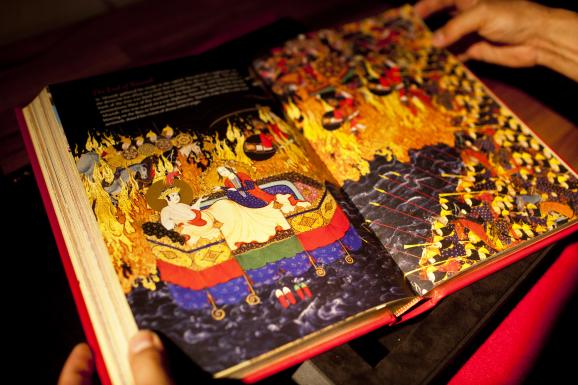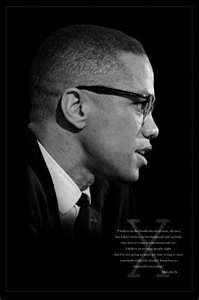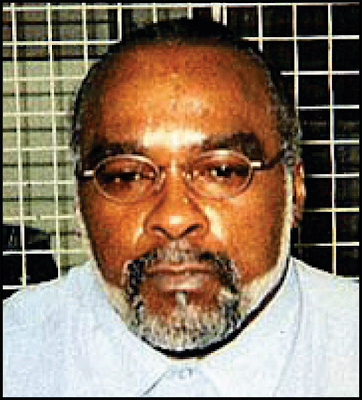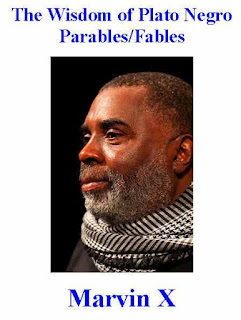This is a bizarre collection. It seems that it has been pulled together as a relentless “anti” to one thing: the Black Arts Movement. Charles Henry Rowell’s introduction and many of the quotes he gleans are aimed at rendering the Black Arts Movement as old school, backward, fundamentally artless. He calls his poets “literary,” i.e., Black Literary poets.--Amiri Baraka
We come from the school Mao talked about in Talks on Art and Literature at Yenan Forum--that all art reflects class interests, either the interests of the masses or the interests of the oppressor and/or bourgeoisie class. I speak the language of the masses because it is the language of truth, no other reason.--Marvin X, Black Arts West
PROSE FROM POETRY MAGAZINE
Angles of Ascent: A Norton Anthology of Contemporary African American Poetry, ed. by Charles Henry Rowell.
W.W. Norton. $24.95.
This is a bizarre collection. It seems that it has been pulled together as a relentless “anti” to one thing: the Black Arts Movement. Charles Henry Rowell’s introduction and many of the quotes he gleans are aimed at rendering the Black Arts Movement as old school, backward, fundamentally artless. He calls his poets “literary,” i.e., Black Literary poets.
The blurb from the publisher W.W. Norton says that the book
This embarrassing gobbledygook was probably a paraphrase of the editor’s personal gobble. But the copywriters might be given a temporary pass because they know nothing about Afro-American literature; it is the Norton “suits” that could be looked at askance because of their ignorant hiring practices.
To get a closer view of where Rowell comes in, look at the quote that he gives from the poet he constantly cites as poetic mentor and as an example of what great poetry should be. The quote is where Rowell got the title of the book, Angles of Ascent:
Rowell says this is an image for the poet’s struggle and transcendence. But Lord, I never did see myself or the poets I admired and learned from as awkward patsies! In 1985, Rowell had Larry Neal on the cover of his literary magazine Callaloo, after Larry’s death from a heart attack at forty-three. You can look in the magazine and see that Larry Neal was no “awkward patsy.” Or that after leaping / falling we would not be glorified by some unidentified “silken rustling in the air, / the angle of ascent / achieved.” Actually it sounds like some kind of social climbing. Ascent to where, a tenured faculty position?
Rowell’s attempt to analyze and even compartmentalize Afro-American poetry is flawed from the jump. He has long lived as the continuing would-be yelp of a Robert Hayden canonization. Back in 1966 I was invited to Fisk University, where Hayden and Rowell taught. I had been invited by Nikki Giovanni, who was still a student at Fisk. Gwen Brooks was there.
Hayden and I got into it when he said he was first an artist and then he was Black. I challenged that with the newly-emerging ideas that we had raised at the Black Arts Repertory Theatre School in Harlem in 1965, just after Malcolm X’s assassination. We said the art we wanted to create should be identifiably, culturally Black — like Duke Ellington’s or Billie Holiday’s. We wanted it to be a mass art, not hidden away on university campuses. We wanted an art that could function in the ghettos where we lived. And we wanted an art that would help liberate Black people. I remember that was really a hot debate, and probably helped put an ideological chip on Rowell’s shoulder.
I find the list of what Rowell calls “Precursors” quite flawed, but it predicts and even prefaces his explanations and choices. He lists Gwendolyn Brooks, Robert Hayden, and Melvin B. Tolson. But how can one exclude Langston Hughes, Sterling Brown, andMargaret Walker, who are the major poets of the period after the Harlem Renaissance? This kind of cherry-picking reveals all too clearly what Rowell means by “literary” poets.
Brooks’s most penetrating works illuminate Black life and the “hood.” Langston, most people know, is the major voice of that period and what we mean when we talk about Afro-American poetry.
What is distinctive about Rowell’s introduction is that just about every page mentions the “Black Arts Movement,” “the Black Aesthetic poets,” “the Black Power Movement” — all like some menacing
political institutions. But that poetry was created in a different time, place, and condition from the verse that Rowell presents here as new
revelation.
Rowell goes on:
Are we being faulted for “hating” slavery, white supremacy, and racism? For trying to fight back, just as the Deacons for Defense and Justice did by routing the Klan in Komunyakaa’s own hometown of Bogalusa, Louisiana?
(Ironically, one of Komunyakaa’s early books was sent to me by a university publisher to ask my opinion if should it be published. My colored patriotism bade me recommend it, though in truth I found it dull and academic.)
But Rita Dove does go on to say something that seems true:
Dove spells out her separation from the Black Arts Movement very honestly, in revealing class terms:
The lynching of Emmett Till, Rosa Parks’s resistance, Dr. King and the Montgomery Bus Boycott (the peoples’ resistance), the bombing of Dr. King’s home in Montgomery. The sit-ins, sclc, the Civil Rights Movement. The emergence of Robert F. Williams and his direct attack on the Klan. The emergence of Malcolm X. I went to Cuba on the first anniversary of the Cuban revolution. The rise and murder of Patrice Lumumba, the African Liberation Movement. I met poets like Askia M. Touré and Larry Neal in front of the un screaming our condemnation of the us, the un, Belgium, Rockefeller for murdering Lumumba and our support for Maya Angelou, Louise Meriwether, Rosa Guy, Abbey Lincoln (all great artists), running up into the un to defy Ralph Bunche. The March on Washington, the bombing 0f 16th St. Baptist Church and the murder of four little girls. JFK’s assassination, Watts, Malcolm’s assassination, Dr. King’s assassination, rebellions across America!
All those major events we lived through. If we responded to them as conscious Black intellectuals, we had to try to become soldiers
ourselves. That is why we wrote the way we did, because we wanted to. We wanted to get away from the faux English academic straitjackets
passed down to us by the Anglo-American literary world.
Rowell thinks the majority of Afro-American poets are MFA recipients or professors. Wrong again! Obviously the unity and struggle in the civil rights and Black Liberation movements have resulted in a slight wiggle of “integration” among the narrowest sector of the Afro-American people. Rowell gives us a generous helping of these university types, many co-sanctioned by the Cave Canem group, which has energized us poetry by claiming a space for Afro-American poetry, but at the same time presents a group portrait of Afro-American poets as mfa recipients.
Rowell organizes his view of Afro-American poetry like this:precursors, Modernists, 1940s–1960s; the black arts movement, The 1960s and Beyond. There’s me, Mari Evans, Nikki Giovanni, Bobb Hamilton, David Henderson, Calvin C. Hernton, Haki Madhubuti, Larry Neal, Carolyn Rodgers, Sonia Sanchez, A.B. Spellman, and Edward S. Spriggs. Where is the great Henry Dumas or Amus Mor, who inspired a whole generation of us? Where are the Last Poets, whether the originals Gylan Kain, David Nelson, Felipe Luciano or the later incarnation Abiodun Oyewole, or Umar Bin Hassan? Most of the poets in the ground-shaking anthology that tried to sum up the Black Arts breakthrough, Black Fire, are nixed.
Of the group “Outside the Black Arts Movement,” Bob Kaufman and LeRoi Jones (Rowell omits Ted Joans) were called “the Black Beats” and had already formed, under the influence of William Carlos Williams, Langston Hughes, and the surrealists, a united front against academic poetry with Allen Ginsberg and the Beats, the San Francisco school, O’Hara and the New York School, Charles Olson and the Black Mountain poets. It was the murder of Malcolm X that sent me and other Black artists screaming out of the various Greenwich Villages to a variety of Harlems!
We saw poets like June Jordan as allies. Check her statement in this anthology: “Poetry is a political act because it involves telling the truth.” Lucille Clifton and I were classmates at Howard, taught by the great Sterling Brown, as were Toni Morrison and A.B. Spellman. Brown’s fundamental insight on America flows through our works.
That Rowell can disconnect Etheridge Knight from the deep spirit of the Black Arts Movement is fraudulent. Sherley Anne Williams says in her blurb, “I remain, more firmly now than then, a proponent of Black consciousness, of ‘The Black Aesthetic’ and so I am a political writer.” You ever read Alice Walker’s marvelous poem “Each One Pull One”?
![]()
Jayne Cortez is obviously close to the spirit of the Black Arts Movement, in the content and force of her poetry, although Rowell stays away from her best known works. Lorenzo Thomas, who actually identified with the Black Arts Movement, is likewise dissed. It is the spirit of resistance, of unity and struggle that connects us. And where is the mighty Sekou Sundiata, whom I first met when he was sixteen at a meeting for those getting ready to go to the 6th Pan African Congress in Dar es Salaam? One of the finest poets of his generation, and not even a mention. Plus no mention of Marvin X, who founded Black Arts West in 1966 with Ed Bullins.
Gaston Neal, criminally underknown, was also director of the New School for Afro-American Thought in dc. His work has yet to be published in its collected version. If you don’t know Sun Ra’s music, it’s doubtful you know his own powerful verse. Other missing significant: Arthur Pfister. Tom Mitchelson, Kalamu ya Salaam, Amina Baraka, Brian Gilmore, Mervyn Taylor, Lamont Steptoe, John Watusi Branch, Everett Hoagland, Devorah Major, Kenneth Carroll, DJ Renegade, Safiya Henderson-Holmes, Charlie Braxton. Where is Nikki Finney? Or the bard of Trenton, Doc Long?
“Outside the Black Arts Movement” (italics mine)? What the Black Arts Movement did was to set a paradigm for the Black artist to be an artist and a soldier. This is what I said at Louis Reyes Rivera’s funeral:
A sharp class distinction has arisen, producing a mini-class of Blacks who benefited most by the civil rights and Black Liberation movements, thinking and acting as if our historic struggle has been won so that they can become as arrogant and ignorant as the worst examples of white America.
It is obvious, as well, looking through this book, that it has been little touched by the last twenty years of Afro-American life, since it shows little evidence of the appearance of spoken word and rap. E.G. Bailey, Jessica Care Moore, Ras Baraka, Ewuare X. Osayande, Zayid Muhammad, Taalam Acey, Rasim Allah, Black Thought, Daniel Beatty, Saul Williams, and Staceyann Chin are all missing. This “new American poetry” is mostly dull as a stick.
Rowell’s icy epilogue is too comic to be tragic, though it is both. It is a cold class dismissal by would-be mainstream Negroes on the path to mediocrity:
As for the Black Power movement’s “death,” last I heard we have an Afro-American president who has taught the Republicans the value of community organizing twice. But what Rowell proves is that the old Black-White dichotomy is in the past, at least on the surface. The struggle, as my wife Amina always says, is about whose side you’re on. Romney and them lost because they don’t even know what country they’re in. Neither does Charles Rowell.
We come from the school Mao talked about in Talks on Art and Literature at Yenan Forum--that all art reflects class interests, either the interests of the masses or the interests of the oppressor and/or bourgeoisie class. I speak the language of the masses because it is the language of truth, no other reason.--Marvin X, Black Arts West
Amiri Baraka Critiques the Norton Anthology of Contemporary African American Poetry
Amiri Baraka Critiques the Norton Anthology of Contemporary African American Poetry
PROSE FROM POETRY MAGAZINE
A Post-Racial Anthology?
Angles of Ascent: A Norton Anthology of Contemporary African American Poetry
 |
| Charles Henry Rowell |
This is a bizarre collection. It seems that it has been pulled together as a relentless “anti” to one thing: the Black Arts Movement. Charles Henry Rowell’s introduction and many of the quotes he gleans are aimed at rendering the Black Arts Movement as old school, backward, fundamentally artless. He calls his poets “literary,” i.e., Black Literary poets.
The blurb from the publisher W.W. Norton says that the book
is not just another poetry anthology. It is a gathering of poems that demonstrate what happens when writers in a marginalized community collectively turn from dedicating their writing to political, social, and economic struggles, and instead devote themselves, as artists, to the art of their poems and to the ideas they embody. These poets bear witness to the interior landscape of their own individual selves or examine the private or personal worlds of invented personae and, therefore, of human beings living in our modern and postmodern worlds.My God, what imbecilic garbage! You mean, forget the actual world, have nothing to do with the real world and real people ... invent it all! You can see how that would be some far-right instruction for “a marginalized community,” especially one with the history of the Afro-American people: We don’t want to hear all that stuff ... make up a pleasanter group of beings with pleasanter, more literary lives than yourselves and then we will perhaps consider it art!
This embarrassing gobbledygook was probably a paraphrase of the editor’s personal gobble. But the copywriters might be given a temporary pass because they know nothing about Afro-American literature; it is the Norton “suits” that could be looked at askance because of their ignorant hiring practices.
To get a closer view of where Rowell comes in, look at the quote that he gives from the poet he constantly cites as poetic mentor and as an example of what great poetry should be. The quote is where Rowell got the title of the book, Angles of Ascent:
He strains, an awk-
ward patsy, sweating strains
leaping falling. Then —
silken rustling in the air,
the angle of ascent
achieved.
— From For a Young Artist, by Robert Hayden
 |
| Amiri Baraka and Larry Neal ca 1967. |
Rowell’s attempt to analyze and even compartmentalize Afro-American poetry is flawed from the jump. He has long lived as the continuing would-be yelp of a Robert Hayden canonization. Back in 1966 I was invited to Fisk University, where Hayden and Rowell taught. I had been invited by Nikki Giovanni, who was still a student at Fisk. Gwen Brooks was there.
Hayden and I got into it when he said he was first an artist and then he was Black. I challenged that with the newly-emerging ideas that we had raised at the Black Arts Repertory Theatre School in Harlem in 1965, just after Malcolm X’s assassination. We said the art we wanted to create should be identifiably, culturally Black — like Duke Ellington’s or Billie Holiday’s. We wanted it to be a mass art, not hidden away on university campuses. We wanted an art that could function in the ghettos where we lived. And we wanted an art that would help liberate Black people. I remember that was really a hot debate, and probably helped put an ideological chip on Rowell’s shoulder.
I find the list of what Rowell calls “Precursors” quite flawed, but it predicts and even prefaces his explanations and choices. He lists Gwendolyn Brooks, Robert Hayden, and Melvin B. Tolson. But how can one exclude Langston Hughes, Sterling Brown, andMargaret Walker, who are the major poets of the period after the Harlem Renaissance? This kind of cherry-picking reveals all too clearly what Rowell means by “literary” poets.
Brooks’s most penetrating works illuminate Black life and the “hood.” Langston, most people know, is the major voice of that period and what we mean when we talk about Afro-American poetry.
 |
| AJASS and the Grandassa Models... part of the Harlem-based Black Arts Movement that was both national and international. |
Rowell goes on:
In other words, the works of these new poets are the direct results of what such poets as Yusef Komunyakaa, Ai, Cyrus Cassells, Rita Dove, Thylias Moss, Toi Derricotte, Harryette Mullen, Nathaniel Mackey — the first wave — dared write, which is whatever they wanted and in whatever forms and styles they desired, as the influence of the Black Arts Movement was first entering its decline.But this is simply a list of poets Rowell likes. I cannot see any stylistic tendency that would render them a “movement” or a coherent aesthetic. Perhaps their only commonality is their “resistance” to the Black Arts Movement. Komunyakaa says:
Growing up in the South, having closely observed what hatred does to the human spirit, how it corrupts and diminishes ... I unconsciously disavowed any direct association with the Black Arts Movement.
 |
| A young Nikki Giovanni. |
(Ironically, one of Komunyakaa’s early books was sent to me by a university publisher to ask my opinion if should it be published. My colored patriotism bade me recommend it, though in truth I found it dull and academic.)
But Rita Dove does go on to say something that seems true:
By the time I started to write seriously, when I was I was eighteen or nineteen years old, the Black Arts Movement had gained momentum; notice had been taken. The time was ripe; all one had to do was walk up to the door they had been battering at and squeeze through the breech.Exactly!
Dove spells out her separation from the Black Arts Movement very honestly, in revealing class terms:
As I wrote more and more ... I realized that the blighted urban world inhabited by the poems of the Black Arts Movement was not mine. I had grown up in Ohio ... I enjoyed the gamut of middle class experience, in a comfy house with picket fences and rose bushes on a tree-lined street in West Akron.But that is not the actual life of the Black majority, who have felt the direct torture and pain of national oppression, and that is what the Black Arts Movement was focusing on, transforming the lives of the Black majority! We wanted to aid in the liberation of the Afro-American people with our art, with our poetry. But the deeper we got into the reality of this task, the more overtly political we became.
The lynching of Emmett Till, Rosa Parks’s resistance, Dr. King and the Montgomery Bus Boycott (the peoples’ resistance), the bombing of Dr. King’s home in Montgomery. The sit-ins, sclc, the Civil Rights Movement. The emergence of Robert F. Williams and his direct attack on the Klan. The emergence of Malcolm X. I went to Cuba on the first anniversary of the Cuban revolution. The rise and murder of Patrice Lumumba, the African Liberation Movement. I met poets like Askia M. Touré and Larry Neal in front of the un screaming our condemnation of the us, the un, Belgium, Rockefeller for murdering Lumumba and our support for Maya Angelou, Louise Meriwether, Rosa Guy, Abbey Lincoln (all great artists), running up into the un to defy Ralph Bunche. The March on Washington, the bombing 0f 16th St. Baptist Church and the murder of four little girls. JFK’s assassination, Watts, Malcolm’s assassination, Dr. King’s assassination, rebellions across America!
 |
| Barbara Jones-Hogu's Unite! 1971. |
Rowell thinks the majority of Afro-American poets are MFA recipients or professors. Wrong again! Obviously the unity and struggle in the civil rights and Black Liberation movements have resulted in a slight wiggle of “integration” among the narrowest sector of the Afro-American people. Rowell gives us a generous helping of these university types, many co-sanctioned by the Cave Canem group, which has energized us poetry by claiming a space for Afro-American poetry, but at the same time presents a group portrait of Afro-American poets as mfa recipients.
Rowell organizes his view of Afro-American poetry like this:precursors, Modernists, 1940s–1960s; the black arts movement, The 1960s and Beyond. There’s me, Mari Evans, Nikki Giovanni, Bobb Hamilton, David Henderson, Calvin C. Hernton, Haki Madhubuti, Larry Neal, Carolyn Rodgers, Sonia Sanchez, A.B. Spellman, and Edward S. Spriggs. Where is the great Henry Dumas or Amus Mor, who inspired a whole generation of us? Where are the Last Poets, whether the originals Gylan Kain, David Nelson, Felipe Luciano or the later incarnation Abiodun Oyewole, or Umar Bin Hassan? Most of the poets in the ground-shaking anthology that tried to sum up the Black Arts breakthrough, Black Fire, are nixed.
Of the group “Outside the Black Arts Movement,” Bob Kaufman and LeRoi Jones (Rowell omits Ted Joans) were called “the Black Beats” and had already formed, under the influence of William Carlos Williams, Langston Hughes, and the surrealists, a united front against academic poetry with Allen Ginsberg and the Beats, the San Francisco school, O’Hara and the New York School, Charles Olson and the Black Mountain poets. It was the murder of Malcolm X that sent me and other Black artists screaming out of the various Greenwich Villages to a variety of Harlems!
We saw poets like June Jordan as allies. Check her statement in this anthology: “Poetry is a political act because it involves telling the truth.” Lucille Clifton and I were classmates at Howard, taught by the great Sterling Brown, as were Toni Morrison and A.B. Spellman. Brown’s fundamental insight on America flows through our works.
That Rowell can disconnect Etheridge Knight from the deep spirit of the Black Arts Movement is fraudulent. Sherley Anne Williams says in her blurb, “I remain, more firmly now than then, a proponent of Black consciousness, of ‘The Black Aesthetic’ and so I am a political writer.” You ever read Alice Walker’s marvelous poem “Each One Pull One”?
Because when we show what we see,It is this spirit that aligns both of them with the Black Arts Movement. And certainly it is this same spirit of self-conscious resistance to American racial or gender craziness that puts Ntozake Shange in that number. The Black Arts spirit is old, it is historical, psychological, intellectual, cultural. It is the same as Black Abolitionist Henry Highland Garnet’s call in 1843 in his “Address to the Slaves of the United States”: “resistance, resistance, resistance.”
they will discern the inevitable:
We do not worship them
We do not worship them.
We do not worship what they have made.
We do not trust them
we do not believe what they say.

Jayne Cortez is obviously close to the spirit of the Black Arts Movement, in the content and force of her poetry, although Rowell stays away from her best known works. Lorenzo Thomas, who actually identified with the Black Arts Movement, is likewise dissed. It is the spirit of resistance, of unity and struggle that connects us. And where is the mighty Sekou Sundiata, whom I first met when he was sixteen at a meeting for those getting ready to go to the 6th Pan African Congress in Dar es Salaam? One of the finest poets of his generation, and not even a mention. Plus no mention of Marvin X, who founded Black Arts West in 1966 with Ed Bullins.
Gaston Neal, criminally underknown, was also director of the New School for Afro-American Thought in dc. His work has yet to be published in its collected version. If you don’t know Sun Ra’s music, it’s doubtful you know his own powerful verse. Other missing significant: Arthur Pfister. Tom Mitchelson, Kalamu ya Salaam, Amina Baraka, Brian Gilmore, Mervyn Taylor, Lamont Steptoe, John Watusi Branch, Everett Hoagland, Devorah Major, Kenneth Carroll, DJ Renegade, Safiya Henderson-Holmes, Charlie Braxton. Where is Nikki Finney? Or the bard of Trenton, Doc Long?
“Outside the Black Arts Movement” (italics mine)? What the Black Arts Movement did was to set a paradigm for the Black artist to be an artist and a soldier. This is what I said at Louis Reyes Rivera’s funeral:
We must urge our artists and scholars ... our most advanced folks fighting for equal rights and self-determination ... to create an art and scholarship that is historically and culturally authentic, that is public and for the people, that is revolutionary.
 |
| A Young Sonia Sanchez. |
It is obvious, as well, looking through this book, that it has been little touched by the last twenty years of Afro-American life, since it shows little evidence of the appearance of spoken word and rap. E.G. Bailey, Jessica Care Moore, Ras Baraka, Ewuare X. Osayande, Zayid Muhammad, Taalam Acey, Rasim Allah, Black Thought, Daniel Beatty, Saul Williams, and Staceyann Chin are all missing. This “new American poetry” is mostly dull as a stick.
Rowell’s icy epilogue is too comic to be tragic, though it is both. It is a cold class dismissal by would-be mainstream Negroes on the path to mediocrity:
Without the fetters of narrow political and social demands that have nothing to do with the production of artistic texts, black American poets, since the Civil Rights Movement and Black Power Movement, have created an extraordinary number of aesthetically deft poems that both challenge the concept of “the American poem” and extend the dimensions of American poetry.This is poppycock at its poppiest and cockiest. You mean the struggle for our humanity is a fetter (to whom? Negroes seeking tenure in these white schools who dare not mumble a cross word?). Why is the struggle for equal rights and self-determination narrow? To whom? Racists? You think Fred Douglass was not one of the greatest artists of the nineteenth century because he kept demanding an end to slavery? Bah, Humbug!
As for the Black Power movement’s “death,” last I heard we have an Afro-American president who has taught the Republicans the value of community organizing twice. But what Rowell proves is that the old Black-White dichotomy is in the past, at least on the surface. The struggle, as my wife Amina always says, is about whose side you’re on. Romney and them lost because they don’t even know what country they’re in. Neither does Charles Rowell.
Originally Published: May 1, 2013






























